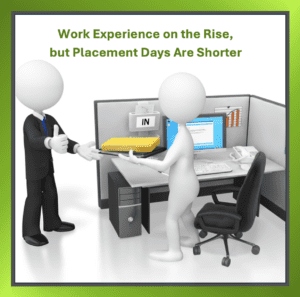Work Experience on the Rise, but Placement Days Are Shorter
Introduction Recent findings suggest that while more Year 10 pupils are gaining work experience, the average placement is shorter than in previous years. *The Key Group’s analysis, published in October 2025, shows 58% of Year 10 pupils completed work experience, the highest level in six years, yet the duration of placements is shrinking.
For HR teams and employers, this trend offers both opportunity and a challenge: how to deliver meaningful early-talent experiences without overburdening your teams.
What the data shows
- Growth in participation: More students are accessing work experience, with participation rising from 43% (2018/19) to 58% in the last academic year.
- Shorter placements: The average duration dropped to just over four days, down from nearly four and a half days the prior year and under five days in 2018/19.
- The value gap: Experts warn that short placements can miss the deeper benefits of work experience unless structured with purpose and guidance.
Expert perspectives and practical implications
- Patrick Philpott, founder of Visionpath: “Work experience doesn’t have to be hard work for the business, but a little time and planning goes a long way.” He emphasises starting with fundamentals, providing a workspace, a buddy, and proactive pre-placement communication to set clear expectations.
- Amrit Sandhar, CEO of HR consultancy Evolve: The impact hinges on attitude and readiness as much as skills. Employers should help young people understand the world of work, including how decisions are made and how teams collaborate. Shadowing, purpose-driven meetings, and explicit explanations of context can elevate the experience beyond observation.
- Lisa Cappuccini, LHH career development lead: View work experience as a talent pipeline, not just a short-term support mechanism. Tailor placements to align with the learner’s development goals, offer cross-team exposure, and maintain regular check-ins to support ongoing growth.
Key takeaways for HR and business leaders
- Structure matters: Assign a clear project or objective for each placement and designate knowledgeable mentors who can guide, explain, and debrief with the student.
- Balance exposure with impact: Provide varied experiences across teams, not just administrative tasks, to build confidence and a sense of contribution.
- Proactive planning pays off: Start planning placements months in advance, with defined outcomes, so both your team and the student can benefit.
- Early intervention and feedback: Regular touchpoints help identify skill gaps, celebrate progress, and reinforce a culture of learning.
- Consider the broader pipeline: Treat work experience as a gateway to potential hires, not just a one-off activity. Align placements with future workforce needs and diversity goals.
What organisations can do next
- For schools and educators: Collaborate with local employers to design placements that deliver measurable learning outcomes and real workplace exposure.
- For employers: Build scalable, repeatable early-talent programs with a simple intake, buddy system, a starter project, and a feedback loop that informs future iterations.
- For policymakers: Consider guidance and incentives that encourage high-quality, long-form placements rather than purely increasing the number of participants.
*About the data The Key Group analysed data from more than 200,700 pupils, focusing on Year 10 (aged 14–15), the window before GCSE-focused preparation intensifies in Year 11.

